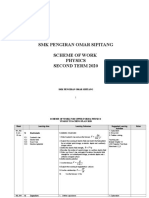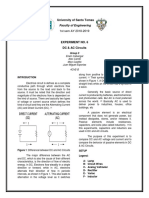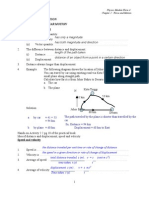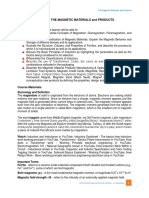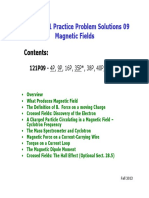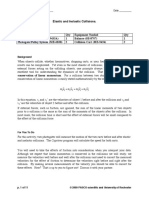Chapter 5
Chapter 5
Uploaded by
aregawi weleabezgiCopyright:
Available Formats
Chapter 5
Chapter 5
Uploaded by
aregawi weleabezgiOriginal Description:
Original Title
Copyright
Available Formats
Share this document
Did you find this document useful?
Is this content inappropriate?
Copyright:
Available Formats
Chapter 5
Chapter 5
Uploaded by
aregawi weleabezgiCopyright:
Available Formats
S
By: Gebremariam Fisseha
Adigrat University, Ethiopia
2009 E.C
Hard Work : Our Hall Mark!
Chapter-5: Magnetic Materials
5.1. Introduction
Magnetism was first discovered ancient Greeks, those near the city of Magnesia, when they
noticed that lodestones, naturally magnetized pieces of the mineral magnetite, could attract iron.
Then the word magnet comes from the Greek term for lodestone, "magnítis líthos" which means
a stone from the region of Magnesia. Thus magnetism can be defined as a physical phenomenon
produced by the motion of electric charge, which results in attractive or repulsive forces between
objects.
All the materials in this universe may be classified either magnetic or non-magnetic. Magnetic
materials are those which are affected by magnetic field and non-magnetic materials are those
which are not affected or slightly affected by magnetic field. Maximum types of materials fall
under category of non – magnetic material. So since magnetic materials found in nature (cobalt
steel, cadmium steel etc.) are very few we alloy materials to create magnetic materials.
Magnetic materials play an important role in the field of electrical engineering. They are used for
making magnetic circuits in electromagnets, machines, relays, transformers, and many
instruments. Magnetic flux is useful for the transformation of energy in a transformer and in
electrical rotating machines.
5.2. Terms Associated with Magnetic Materials
a) Magnetic field: All magnetic fields are created by moving charged particles. Even in
magnet the magnetic field is due to the electrons that are constantly moving around inside.
Thus magnetic field can be defined as is the space around a magnet or current carrying
conductor within which magnetic effects can be observed.
b) Field strength: Magneto-motive force is a scalar quantity that is a measure of the sources
of magnetic flux in a magnetic circuit. The magneto-motive force per meter length of the
magnetic circuit (Which is homogeneous and of uniform cross-sectional area) is called
magnetic field strength or field intensity. It is represented by symbol H.
c) Flux or lines of force: The total magnetic lines of flux passing through the material are
called magnetic flux. Its symbol is Ø and unit of measurement is Weber.
d) Magnetic circuit: It is a path of magnetic flux forming a closed circuit.
Department of Electrical Engineering Electrical Materials and Technology (ECEg3133 ) 1
2009E.C
Hard Work : Our Hall Mark!
e) Magnetic force: It is the force exerted by one magnet on another either to attract or to
repel it.
f) Permeability ( μ ):
It is the ability of a material to respond to how much electromagnetic flux it can support to
pass through itself within an applied electromagnetic field. In other words magnetic
permeability is property of a material that describes the ease with which a magnetic flux is
established in the component.
In electromagnetism, H is known as the magnetizing force that signifies the ability of
magnetic dipole organizations in any material or medium by magnetic field density B. The
relation between B and H is directly proportional,B= μH. So, in other word magnetic
permeability is defined as the ratio of magnetic flux density (B) of a material to its electro-
B
magnetizing force (H), μ = .
H
Permeability of free pace is given as μ0 = 4ᴫ × 10-7 H/m. The conducting power of a
substance for magnetic lines of forces as compared with air is called relative permeability
(μr).It value of varies from material to material and also depends upon the degree to
which the material is magnetized.
So, permeability of any medium or material is given by:
μ= μr μo
Where: μo = the permeability of free space
μ = Permeability of the material
μr = Relative Permeability of the material
g) Reluctance: Reluctance is the resistance to magnetic flow or it is the opposition offered to
the flow of magnetic lines of force. It is denoted by S.
S = l/ μo*μ*A
Where: l = length of magnetic path in meters
μo = the permeability of free space
μ = Permeability of the material
A = Cross sectional area of the magnetic material
h) Magneto-motive force: It is that force which drives or tends to drive the flux through a
magnetic circuit. It is symbolized by MMF.
Department of Electrical Engineering Electrical Materials and Technology (ECEg3133 ) 2
2009E.C
Hard Work : Our Hall Mark!
MMF = Number of turns* Current passing through the magnetic circuit = N*I
i) Residual magnetism: It is defined as the magnetic flux density which still remains in a
magnetic material even when the magnetizing force is completely removed.
j) Retentivity: Is the power of retaining magnetism even after the induced magnet is
removed.
k) Coercive force: It may be defined as that demagnetizing force which is necessary to
neutralize completely the magnetism in an electro-magnet after the value of magnetizing
force becomes zero.
l) Magnetic Susceptibility: Magnetic susceptibility is the degree of magnetization of a
material in response to an applied magnetic field. If magnetic susceptibility is positive
then the material can be paramagnetic, ferromagnetic, ferrimagnetic, or
antiferromagnetic. In this case the magnetic field is strengthened by the presence of the
material. Alternatively, if magnetic susceptibility is negative the material is diamagnetic.
As a result, the magnetic field is weakened in the presence of the material.
5.3. Magnetic dipole moment
Magnetic dipole is arrangement of two equal and opposite magnetic poles which is separated by
a small distance. There two kinds of dipoles, the magnet and electric current loop.
Magnet is a magnetic dipole with magnetic field lines coming out of the north and going into the
north. Because we can never separate north and south no magnetic monopoles like an isolated
north pole of a magnet has ever been observed in nature.
A current loop produces similar magnetic field. Since it produces magnetic field just like a
magnetic dipole, a current loop is also a magnetic dipole. The magnet created by a current is
called electro magnet.
Department of Electrical Engineering Electrical Materials and Technology (ECEg3133 ) 3
2009E.C
Hard Work : Our Hall Mark!
Figure 5.1: Magnetic dipoles
A magnetic dipole has a magnetic dipole moment which represents the direction and strength of
the dipole. For direction we use the field direction at the center to represent the direction of
dipole moment. So we can join upward arrows to represent each of them as shown in figure 5.2.
The magnetic dipole moment of a current loop enclosing an area A is defined as:
Figure 5.2: Direction of magnetic dipole moment
For the strength of dipole moment, in case of a magnet the stronger the magnet the larger the
dipole moment. For current loop the larger the current and/or loop area the stronger the dipole
moment.
When we place a magnetic dipole in a much stronger the external magnetic field, the dipole will
align with the external magnetic field. So does the magnetic dipole moment vector aligns with
5.4. Types of Magnetism and domain movement in external magnetic field
The magnetic properties of the materials are characterized by their relative permeability. Thus in
accordance with the value of relative permeability, the magnetic materials may be classified in
the following categories.
All these magnetic materials contain magnetic moments, which behave in a way similar to
microscopic bar magnets. When these magnetic moments are aligned and point to the same
direction the material is said to be magnetized and the region in which the magnetization is in
uniform direction is called magnetic domain. These magnetic moments have different response
to the external applied magnetic field in the different types of magnetic materials as discussed
below.
1) Paramagnetic Materials(μr is near about 1 but not exactly 1):
Department of Electrical Engineering Electrical Materials and Technology (ECEg3133 ) 4
2009E.C
Hard Work : Our Hall Mark!
In paramagnetic materials, the magnetic moments tend to be randomly orientated due to
thermal fluctuations when there is no magnetic field. In an applied magnetic field these
moments start to align parallel to the field such that the magnetization of the material is
proportional to the applied field. Unlike ferromagnets, paramagnets do not retain any
magnetization in the absence of an externally applied magnetic field because thermal
motion randomizes the spin orientations. Thus the total magnetization drops to zero
when the applied field is removed. Aluminum, platinum, and oxygen are examples of
paramagnetic materials.
2) Ferromagnetic materials (μr is greater than 1):
The second way that materials can react is by not only aligning themselves with the
external magnetic field, as with paramagnetic materials, but actually staying aligned after
the magnetic field is removed. Such materials are called ferromagnetic. When cooled
below a temperature called the Curie temperature, the magnetization of a piece of
ferromagnetic material spontaneously divides into many small regions called magnetic
domains. Iron, cobalt, and nickel are examples of Ferromagnetic materials.
3) Diamagnetic materials (μr is less than 1) :
Now most atoms with a magnetic moment that are neither ferromagnetic nor
paramagnetic are diamagnetic. The atoms have no net magnetic moment when there is no
applied field, but once external field applied domains are aligned in the opposite direction
Department of Electrical Engineering Electrical Materials and Technology (ECEg3133 ) 5
2009E.C
Hard Work : Our Hall Mark!
from the external magnetic field. What this means are those diamagnetic materials tend to
move away from magnetic fields. Silver, copper, and hydrogen are examples of
diamagnetic materials.
5.5. Spontaneous magnetization and the Curie Weiss law
Domains are regions of magnetic substances that have a free, spinning electron. When these
domains line up, the substance becomes a magnet. Weiss postulated that an internal molecular
field causes a parallel alignment of magnetic dipoles and sets up spontaneous magnetization in a
ferromagnetic material. When we say spontaneous magnetization we mean that the appearance
of an ordered spin state(magnetization) at zero applied magnetic field in a ferromagnetic material
which exists only below a critical point called the Curie temperature or TC.
The properties of all magnetic materials change when they are heated to a particular temperature.
When ferromagnetic materials are heated, the degree of alignment of the atomic magnetic
moments decreases and hence the saturation magnetization also decreases. Eventually when the
thermal agitation becomes so great that the material becomes paramagnetic (unable to retain
magnetism when the external field is removed). The Curie temperature (Tc), or Curie point, is
the maximum temperature at which the atomic structure of magnetic material is changed and
the object becomes demagnetized .Once heated to, or passed, the Curie point the magnetic
domains of the material are released and become, resulting in permanent magnetic damage. As a
result, the magnet will not emit any external magnetic fields.
Permanent magnetism is caused by the alignment of magnetic moments and induced magnetism
is created when disordered magnetic moments are forced to align in an applied magnetic field.
For example, the ordered magnetic moments (ferromagnetic, Figure 1) change and become
disordered (paramagnetic, Figure 2) at the Curie temperature. Higher temperatures make
magnets weaker, as spontaneous magnetism only occurs below the Curie temperature. Hence the
Department of Electrical Engineering Electrical Materials and Technology (ECEg3133 ) 6
2009E.C
Hard Work : Our Hall Mark!
Curie temperature (TC), or Curie point, is the temperature at which certain materials lose their
permanent magnetic properties, to be replaced by induced magnetism.
Figure 5.3: Curie Weiss law
Above the Curie temperature, the moments are oriented randomly, resulting in a zero net
magnetization. In this region the substance is paramagnetic, and its susceptibility is given by
i.e. χ ∝ 1 χ= c …(the curie Weiss law)
T Tc T Tc
which is the Curie-Weiss law. The constant C is called the Curie constant and TC is the Curie
temperature in kelvin.
The law predicts a singularity in the susceptibility at T=Tc. Below this temperature the
ferromagnetic has a spontaneous magnetization, because if χ is infinite so that we can have a
finite M for zero B0.
The Curie-Weis law describes the observed susceptibility variation in the paramagnetic region
above the Curie point and shows that the magnetic susceptibility of a paramagnetic dipole is
inversely proportional to the absolute temperature.
Department of Electrical Engineering Electrical Materials and Technology (ECEg3133 ) 7
2009E.C
Hard Work : Our Hall Mark!
5.6. Magnetic losses, Complex permeability
5.6.1 Magnetic losses
The losses that can occur in a magnetic material are iron losses. These losses are caused by the
alternating flux in the core and consist of hysteresis and eddy current losses.
A time-variable magnetic field in a metallic material not only induces electrical currents on its
surface, parasitic or eddy currents, but also generates displacements in the domain walls of the
material.
Eddy current loss:
When an alternating magnetic field is applied to a magnetic material an emf is induced on the
surface of the material which in turn produces an induced current on the surface of the material
according to Faraday’s Law of Electromagnetic induction. These induced currents which
circulate on the surface of the material are called eddy currents. As these currents are not
responsible for doing any useful work, but produces a loss (I2R loss) in the magnetic material.
This loss is termed as Eddy Current Loss.
Hysteresis loss:
Hysteresis is the tendency of a system's behavior to depend on its history. We can more generally
say it is the tendency to take one path in one direction, and another in the reverse direction. A
well-known system that exhibits hysteresis are ferromagnetic materials such as iron.
When a ferromagnetic material is magnetized in one direction, the molecules of the magnetic
material are aligned in one particular direction and when this magnetic force is reversed in the
opposite direction, the internal friction of the molecular magnets opposes the reversal of
magnetism. Thus the material’s magnetization will not come back to zero when the imposed
magnetizing field is removed. This phenomenon is termed as Magnetic Hysteresis..
To wipe out or overcome this internal friction or in other words known as residual magnetism, a
part of the magnetizing force in opposite direction is used. The work, done by this magnetizing
force produces heat; this wastage of energy in the form of heat is termed as hysteresis loss.
Department of Electrical Engineering Electrical Materials and Technology (ECEg3133 ) 8
2009E.C
Hard Work : Our Hall Mark!
A great deal of information can be learned about the magnetic properties of a material by
studying its hysteresis loop. A hysteresis loop shows the relationship between the induced
magnetic flux density (B) and the magnetizing force (H). It is often referred to as the B-H loop.
An example hysteresis loop is shown below.
Figure 5.4: Magnetic hysteresis loop of a ferromagnetic material
The loop is generated by measuring the magnetic flux of a ferromagnetic material while the
magnetizing force is changed. A ferromagnetic material that has never been previously
magnetized or has been thoroughly demagnetized will follow the dashed line as H is increased.
As the line demonstrates, the greater the amount of current applied (H+), the stronger the
magnetic field in the component (B+).
At point "a" almost all of the magnetic domains are aligned and an additional increase in the
magnetizing force will produce very little increase in magnetic flux. The material has reached the
point of magnetic saturation.
When H is reduced to zero, the curve will move from point "a" to point "b." At this point, it can
be seen that some magnetic flux remains in the material even though the magnetizing force is
zero. This is referred to as the point of retentivity on the graph and indicates the remanence or
Department of Electrical Engineering Electrical Materials and Technology (ECEg3133 ) 9
2009E.C
Hard Work : Our Hall Mark!
level of residual magnetism in the material. (Some of the magnetic domains remain aligned but
some have lost their alignment.)
As the magnetizing force is reversed, the curve moves to point "c", where the flux has been
reduced to zero. This is called the point of coercivity on the curve. The reverse magnetic field or
force required to remove the residual magnetism from the material so that the net flux within
the material is zero is called the coercive force or coercivity of the material.
As the magnetizing force is increased in the negative direction, the material will again become
magnetically saturated but in the opposite direction (point "d"). Reducing H to zero brings the
curve to point "e." It will have a level of residual magnetism equal to that achieved in the other
direction. Increasing H back in the positive direction will return B to zero.
Notice that the curve did not return to the origin of the graph because some force is required to
remove the residual magnetism. The curve will take a different path from point "f" back to the
saturation point where it with complete the loop. This kind of Hysteresis Curve illustrates a
lagging tendency. It takes a lot of H before B gets large, and the remanent B resists changes in B
until overcome by a saturating amount of H.
5.6.2 Complex Permeability
Magnetic properties of materials are due to the interactions of external magnetic fields and
moving charges in the materials. Due to the orbiting electrons internal field is generated inside
the material. This internal field is either aligned with the external field to increase the total field
or opposes it to decrease the total field. If the internal magnetic moments are randomly oriented,
the net internal field is zero and the material behaves like a space from magnetic point of view.
Hence a total magnetization vector M exists in the material, in the presence of an external
magnetic field.
The Magnetization vector M is given as:
M= μ0XmH
Where: μ0 – permeability of free space
χm – magnetic susceptibility of the material and is generally complex.
Department of Electrical Engineering Electrical Materials and Technology (ECEg3133 ) 10
2009E.C
Hard Work : Our Hall Mark!
Then the equation for complex permeability will be:
The imaginary part of the complex permeability represents losses due to damping forces in the
magnetic material. Since there are no magnetic currents, we cannot view these losses as
conduction losses.
Magnetic material materials are characterized by the existence of magnetic domains. Within a
single domain, all atomic magnetic moments are parallel to a given crystallographic direction,
called the easy axis of magnetization. In the absence of an external magnetic field, a piece of
bulk ferromagnetic material is composed of randomly oriented magnetic domains. A time-
variable magnetic field in a metallic material not only induces electrical currents on its surface,
parasitic or eddy currents, but also generates displacements in the domain walls of the material.
5.7. Hard and soft magnetic materials
Magnetic materials are further classified as soft or hard according to the ease of magnetization.
Hard magnetic materials: Soft magnetic materials:
Difficult to magnetize, difficult to Easily magnetized, easily demagnetized
demagnetize Used for making temporary magnets
Since they retain their magnetism used to Have low hysteresis loss due to small
make permanent magnet hysteresis loop area
Have large hysteresis loss due to large High susceptibility and permeability
hysteresis loop area Less coercively and retentivity values
Low susceptibility and permeability Magnetic energy stored is less
Large coercively and retentivity values Low eddy current loss due to high
Magnetic energy stored is high resistivity
Eddy current loss is high
Strong magnetic reluctance
Department of Electrical Engineering Electrical Materials and Technology (ECEg3133 ) 11
2009E.C
Hard Work : Our Hall Mark!
5.8. Macroscopic Characterization of Magnetic Materials
An important aspect of materials science is the characterization of the materials that we use or
study in order to learn more about them. The first step in any characterization of a material or an
object made of a material is often a macroscopic observation. This is simply looking at the
material with the naked eye. This simple process can yield a large amount of information about
the material such as the color of the material, its luster, its shape, crystalline form,its
composition, its structural features etc.
In case of characterization of magnetic materials, we refer the determination of the dependence
of the macroscopic magnetization (M) on the effective magnetic field in the material (H).It is
customary to plot the magnetization M of the sample as a function of the magnetic field strength
H, since H is a measure of the externally applied field which drives the magnetization .
5.9. Application of Magnetic Materials
To operate electrical motors, generators and transformers.
To make strong permanent magnets
In data storage technology (computer hard disks, computer disks, video and audio
cassettes etc.)
In loudspeakers, telephones, CD players, TV and video recorders
Department of Electrical Engineering Electrical Materials and Technology (ECEg3133 ) 12
2009E.C
You might also like
- Resistivity QDocument28 pagesResistivity QJellyfishNo ratings yet
- Elasticity QuizDocument5 pagesElasticity QuizTuck Diery0% (1)
- PHY094 Past Years QuestionDocument7 pagesPHY094 Past Years QuestionShafiqah IsmailNo ratings yet
- Content-Based Discussion (Benzene)Document46 pagesContent-Based Discussion (Benzene)nang kubaiNo ratings yet
- Matriculation Physics Electromagnetic InductionDocument96 pagesMatriculation Physics Electromagnetic Inductioniki292No ratings yet
- Light Intensity LabDocument4 pagesLight Intensity LabNkindé Ambalo100% (1)
- Instruction Manual L&TDocument16 pagesInstruction Manual L&TVijay67% (3)
- RPH (F5) PhysicsDocument8 pagesRPH (F5) PhysicsidulNo ratings yet
- Lecture Note 1 - 1Document39 pagesLecture Note 1 - 1Mohamad Faiz100% (3)
- Electricity Form 5 Chap 2 MalaysiaDocument104 pagesElectricity Form 5 Chap 2 MalaysiaJamil MaslanNo ratings yet
- Band Theory NotesDocument14 pagesBand Theory NotesjoeNo ratings yet
- Bernoulli'S Principle: Science Form 5Document8 pagesBernoulli'S Principle: Science Form 5Huda TahaNo ratings yet
- Yearly Lesson Plan Physics Form 5 Year 2016: Learning Area: WavesDocument19 pagesYearly Lesson Plan Physics Form 5 Year 2016: Learning Area: WavesRed KiteNo ratings yet
- 9702 p1 Work Energy Power AllDocument15 pages9702 p1 Work Energy Power AllkwaikunNo ratings yet
- Model Questions PhysicsDocument10 pagesModel Questions PhysicsCharis Israel AnchaNo ratings yet
- Experiment 6: Centripetal Force: (F Ma) - The Acceleration of An Object Moving in Uniform Circular Motion Is A VDocument6 pagesExperiment 6: Centripetal Force: (F Ma) - The Acceleration of An Object Moving in Uniform Circular Motion Is A VAnonymous 75TDy2yNo ratings yet
- Chapter 6 Quantum Physics StudentDocument3 pagesChapter 6 Quantum Physics StudentKhairul AznizamNo ratings yet
- Micro WindDocument14 pagesMicro Windlak_prabNo ratings yet
- SPM Physics Form 4 Chapter 5 Light NotesDocument26 pagesSPM Physics Form 4 Chapter 5 Light NotesManisha Sekaran Muniandy100% (3)
- 3.2 Liquid Pressure 2012Document12 pages3.2 Liquid Pressure 2012cikgusuriyati100% (1)
- SMK Tinggi Klang Trial Term 1 2014Document13 pagesSMK Tinggi Klang Trial Term 1 2014Souseiseki ChromeNo ratings yet
- Magnetic Forces and Fields: (Chapter 12)Document48 pagesMagnetic Forces and Fields: (Chapter 12)Allan Gabriel LariosaNo ratings yet
- Intermediate Electromagnetic Theory PDFDocument49 pagesIntermediate Electromagnetic Theory PDFMalvado Aun Mas Malvado0% (2)
- Physics PEKA 1 Tingkatan 4Document6 pagesPhysics PEKA 1 Tingkatan 4Anand KukrejaNo ratings yet
- STPM Physics Formulas (Derived)Document3 pagesSTPM Physics Formulas (Derived)Fu HongNo ratings yet
- Experiment 7 Interference at A Fresnel's Mirror With An He-Ne LaserDocument8 pagesExperiment 7 Interference at A Fresnel's Mirror With An He-Ne LaserPareen JainNo ratings yet
- Am Transmitter: Department of Electronics Engineering School of Engineering and Architecture Saint Louis UniversityDocument19 pagesAm Transmitter: Department of Electronics Engineering School of Engineering and Architecture Saint Louis UniversitySubaru_101100% (1)
- SPM 4531 2005 Physics p1 BerjwpDocument15 pagesSPM 4531 2005 Physics p1 Berjwppss smk selandarNo ratings yet
- Phy098 Problem Solving AssignmentDocument12 pagesPhy098 Problem Solving AssignmentMUHAMMAD FIKRI BATHURUL ZAMAN SHAHNo ratings yet
- Laboratory ReportDocument9 pagesLaboratory ReportXuan ChuaNo ratings yet
- 2 Report ExampleDocument2 pages2 Report ExampleEngku AzrimNo ratings yet
- Tutorial Chapter 6Document3 pagesTutorial Chapter 6malzNo ratings yet
- Assignment Mat097Document25 pagesAssignment Mat097Nur AdeelaNo ratings yet
- The Photoelectric Effect and Its Application in The Digital CameraDocument2 pagesThe Photoelectric Effect and Its Application in The Digital Cameraallison125No ratings yet
- Chapter 2 - Carrier Transport PhenomenaDocument54 pagesChapter 2 - Carrier Transport PhenomenaDesmond Kuek100% (2)
- Statics: ES 113 Mr. MoadiDocument49 pagesStatics: ES 113 Mr. MoadiDerrick Maatla MoadiNo ratings yet
- The Simple PendulumDocument2 pagesThe Simple PendulumphoenixchiaNo ratings yet
- Centripetal Force LabDocument8 pagesCentripetal Force LabGrant BrownNo ratings yet
- EXPERIMENT PhET InductionDocument5 pagesEXPERIMENT PhET Inductionfaiz shukri0% (1)
- INORGANIC Periodic Table 1Document26 pagesINORGANIC Periodic Table 1ThilagaNo ratings yet
- Sains Mini ProjectDocument2 pagesSains Mini ProjectVARSHNEE A/P ARUL RAJAN MoeNo ratings yet
- Fine Beam TubeDocument11 pagesFine Beam TubeAkikazenNo ratings yet
- RPT Physics STPM Term 2 2020Document8 pagesRPT Physics STPM Term 2 2020marcella silunNo ratings yet
- RPT Physics F6 Second Term 2019Document8 pagesRPT Physics F6 Second Term 2019Norhazli IbrahimNo ratings yet
- Matriculation Physics (X-Rays)Document44 pagesMatriculation Physics (X-Rays)ridwan100% (2)
- Application For The Position of A Physics/Mathematics TeacherDocument1 pageApplication For The Position of A Physics/Mathematics TeachersorbariNo ratings yet
- EXP 2.2 EmfDocument2 pagesEXP 2.2 EmfNazirah RohanipNo ratings yet
- Gravitation (2 Hours)Document54 pagesGravitation (2 Hours)elty Tan50% (2)
- Trial STPM Physics Term 2 - Module 1Document12 pagesTrial STPM Physics Term 2 - Module 1annahiaz0% (1)
- Practice Assignment Work Energy and PowerDocument3 pagesPractice Assignment Work Energy and PowerAyush GogiaNo ratings yet
- Experiment 1 PHY260Document8 pagesExperiment 1 PHY260MuhammadAsyraf100% (1)
- Experiment 6 Lab ReportDocument3 pagesExperiment 6 Lab ReportErwin CabangalNo ratings yet
- Chapter 2 Force and Motion TEACHER's GUIDEDocument45 pagesChapter 2 Force and Motion TEACHER's GUIDEMohd Khairul Anuar100% (7)
- Geiger Lab ReportDocument8 pagesGeiger Lab Reportmusu.yanguba9329100% (1)
- ConclusionDocument4 pagesConclusionali amerNo ratings yet
- Lab Manual Exp 4Document7 pagesLab Manual Exp 4shirzNo ratings yet
- Symbol PDFDocument3 pagesSymbol PDFJulia ZhangNo ratings yet
- Magnetic Field and Magnetic Force: B V F FDocument21 pagesMagnetic Field and Magnetic Force: B V F FscholsarNo ratings yet
- The Magnetic Materials and Products 2021Document17 pagesThe Magnetic Materials and Products 2021Lara Mae BuragayNo ratings yet
- Module 3 - Lecture Notes - Engineering PhysicsDocument34 pagesModule 3 - Lecture Notes - Engineering PhysicsDamodhar reddy GarlapatiNo ratings yet
- CANQUE MagnetismDocument7 pagesCANQUE MagnetismAvelyn Mary Canque ClarionNo ratings yet
- Magnetic MaterialDocument83 pagesMagnetic MaterialNivashini VindhyaNo ratings yet
- Endalcachew PDFDocument10 pagesEndalcachew PDFaregawi weleabezgiNo ratings yet
- Endalcachew PDFDocument10 pagesEndalcachew PDFaregawi weleabezgi100% (1)
- 1-0-1 Computer Basics Student Manual PDFDocument21 pages1-0-1 Computer Basics Student Manual PDFMay ann argenioNo ratings yet
- Chapter 5 Process ControlDocument53 pagesChapter 5 Process Controlaregawi weleabezgiNo ratings yet
- Chapter - 1 Earth MaterialsDocument55 pagesChapter - 1 Earth Materialsaregawi weleabezgiNo ratings yet
- C++ Worksheet $ AssignmentDocument14 pagesC++ Worksheet $ Assignmentaregawi weleabezgiNo ratings yet
- CH 3 PDFDocument12 pagesCH 3 PDFaregawi weleabezgiNo ratings yet
- Temperatue and DiplacementDocument63 pagesTemperatue and Diplacementaregawi weleabezgi100% (1)
- Chapter 5Document16 pagesChapter 5aregawi weleabezgiNo ratings yet
- Chapter Two - Lecture - 02Document47 pagesChapter Two - Lecture - 02aregawi weleabezgiNo ratings yet
- Chapter TwoDocument44 pagesChapter Twoaregawi weleabezgiNo ratings yet
- Transmission Line ParameterDocument75 pagesTransmission Line Parameteraregawi weleabezgi100% (1)
- ppt3 Measurt PDFDocument74 pagesppt3 Measurt PDFaregawi weleabezgiNo ratings yet
- Chapter 4Document20 pagesChapter 4aregawi weleabezgiNo ratings yet
- Chapter 6Document13 pagesChapter 6aregawi weleabezgi100% (1)
- Physics 121 Practice Problem Solutions 09 Magnetic Fields: ContentsDocument12 pagesPhysics 121 Practice Problem Solutions 09 Magnetic Fields: ContentsnancyNo ratings yet
- M V V V V: Name - DateDocument11 pagesM V V V V: Name - Datek tNo ratings yet
- Lesson 1: Momentum & ImpulseDocument5 pagesLesson 1: Momentum & Impulsecattleya abelloNo ratings yet
- Evolution of The Electric Power Components Definitions: Adrian A. Adăscăliţei, Alexander E. EmanuelDocument6 pagesEvolution of The Electric Power Components Definitions: Adrian A. Adăscăliţei, Alexander E. EmanuelhanifNo ratings yet
- Kcse 2012 Kericho Mock Physics q1Document12 pagesKcse 2012 Kericho Mock Physics q1Mary BaiteNo ratings yet
- 4 Colligative Properties of SolutionsDocument84 pages4 Colligative Properties of SolutionsujargohandiNo ratings yet
- Chapter 4 Force and Newtons Laws of MotionDocument23 pagesChapter 4 Force and Newtons Laws of MotionQassem MohaidatNo ratings yet
- How Is Reactive Power Produced - What Are The Effects of Reactive Power in The Grid - QuoraDocument5 pagesHow Is Reactive Power Produced - What Are The Effects of Reactive Power in The Grid - QuoraMahesh Kumar BhattaNo ratings yet
- HIGH VOLTAGE Module 3Document84 pagesHIGH VOLTAGE Module 3prasadacharNo ratings yet
- Eu Ls10 Spec Guide enDocument4 pagesEu Ls10 Spec Guide enİbrahim AlkoçNo ratings yet
- Applied Mathematics Handbook PDFDocument148 pagesApplied Mathematics Handbook PDFShaan ChadhaNo ratings yet
- Eet Exam Paper Two 2018Document10 pagesEet Exam Paper Two 2018starkmanyayaNo ratings yet
- Lecture 03 (2 Weeks) Three-Phase CircuitsDocument33 pagesLecture 03 (2 Weeks) Three-Phase Circuitsmarawan ahmedNo ratings yet
- Mechanics Level 1Document23 pagesMechanics Level 1abrandcalledpowwowNo ratings yet
- Energy, Energy Transfer, and General Energy AnalysisDocument23 pagesEnergy, Energy Transfer, and General Energy AnalysisBen RileyNo ratings yet
- Surveying FormulasDocument8 pagesSurveying FormulasRomaricHoumbieNo ratings yet
- Calulation of Ps Class CT For 20-25mva TrafoDocument7 pagesCalulation of Ps Class CT For 20-25mva TrafoUmang JainNo ratings yet
- Coaxial Transmission LineDocument34 pagesCoaxial Transmission LineDancerNo ratings yet
- Walliah & Jaydens Geothermal InfographicDocument1 pageWalliah & Jaydens Geothermal Infographicmy trapNo ratings yet
- Chamindabandara 2021Document18 pagesChamindabandara 2021simamovic4No ratings yet
- Normas para Determinação de Viscosidade de Tintas e VernizesDocument28 pagesNormas para Determinação de Viscosidade de Tintas e VernizesPollyanna MaraNo ratings yet
- Engineering Mechanics LectureDocument12 pagesEngineering Mechanics LectureMeverlyn RoqueroNo ratings yet
- Uniform Acceleration On An Inclined Plane I. ObjectivesDocument6 pagesUniform Acceleration On An Inclined Plane I. ObjectivesNikkaNo ratings yet
- Uygulama Örnekleri: Application ExamplesDocument29 pagesUygulama Örnekleri: Application ExamplesAygit KaraNo ratings yet
- EE141 TextDocument144 pagesEE141 TextIqbal MuhammadNo ratings yet
- Machine Designdocx PDF FreeDocument324 pagesMachine Designdocx PDF FreeJessie DoqueniaNo ratings yet
- Physics 2 Lab ManualDocument104 pagesPhysics 2 Lab ManualJeanne JacksonNo ratings yet
- 1 HCV Unit and DimensionsDocument40 pages1 HCV Unit and DimensionsKanika SinghNo ratings yet










































